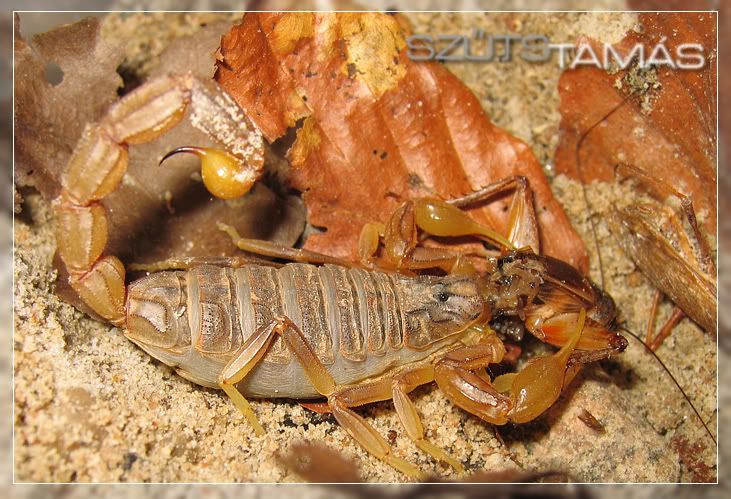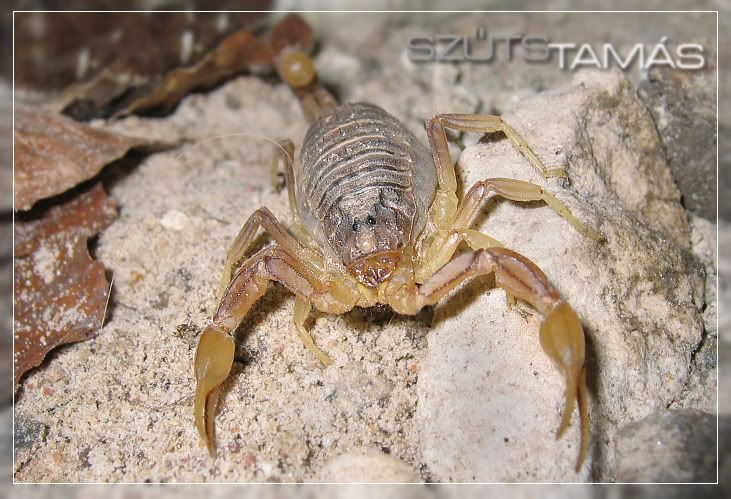A neten böngészvén akadtam rá egy új Wilson Lourenco cikkre, melyben a Szahara Buthidae családba tartozó skorpióiról ír egy egész kellemes, mintegy 15 oldalas kis szösszenet, lélegzetelállítóan jó rajzokkal. Két új génuszt írnak le a Saharobuthus nevűt, melynek etimológiáját (néveredetét nem kellene össze keverni a Saccaromycetes nevű mikrobákkal :P), illetve a Panthobuthus nemet. Hátpajzsrajzok 8 génuszra, összehasonlítás ezzel azzal. Igazság szerint ezeket a karaktereket akár már egy jobb lupéval vagy gyengébb mikroszkóppal is meg lehet vizsgálni, tehát mehet a sufnitaxonómia ezerrel. 
A cikk egyben megadta az apropót arra is, hogy a skoreszos képeiről lefújjam a pórt port. A képek egy Canon Digital Ixus 5 MP-s automata géppel készültek. Istenigazából azért mutatom be őket, hogy azért azzal is lehet.



Aki szívesen beleolvasna a cikkbe és az adott újsághoz nincs hozzáférése, annak a cikket szívesen elküldöm, miután nekifutna a az alant olvasható angol szövegnek (ami nem szak) és annak magyar megfelelőjét a DNFS fodítások topikjában elhelyezte (a szabályok egy éve nem változtak). Google “tranzlátorok”, fordítógépesek kíméljenek. As emphasised in recent publications (Qi and Lourenço 2007), scorpion diversity is particularly high in deserts and arid formations (Polis 1990). Th e scorpion fauna of North Africa, particularly the one specifically adapted to the Sahara desert has been the subject of intensive study, synthesised in the monographic work of Vachon (1952). Neverless, more detailed inventory work, and the revision of classical groups has revealed an increasing number of new species and even new genera. These have been the subject of several recent publications (e. g. Lourenço 1998a, 1999a,b, 2001a, 2002a, 2003, 2005a, 2006; Lourenço and Duhem 2007; Lourenço et al. 2003; Qi and Lourenço 2007). From these, it is apparent that knowledge of this fauna is still far from complete, and many other species, and probably genera too, await discovery. Moreover, the precise patterns of distribution of most taxa are yet only poorly understood. A similar assumption can be made about the fauna of the entire Palaearctic region since a great variety of scorpion genera inhabit the Middle East and Central Asia (Vachon 1958; Levy and Amitai 1980; Vachon and Kinzelbach 1987; Sissom 1990; Fet and Lowe 2000; Fet et al. 2003). The desert areas of the Palaearctic region have been a rich source of speciation for several animal taxa (Kryzhanovsky 1965). It is assumed that extensive aridity during the Tertiary period in the southern Palaearctic region facilitated radiation among scorpions (Nenilin and Fet 1992; Fet 1994; Fet et al. 1998, 2003) as well as in other groups of organisms. Fet et al. (2001) drew particular attention to the diversity of psammophilic scorpions from the Palaearctic deserts of central and southern Asia. Th ese authors described a new genus and species of buthid scorpion from the Baluchistan Province of Iran, and presented a very complete table of characters for six buthid psammophilic genera, Anomalobuthus Kraepelin, 1900, Liobuthus Birula, 1898, Plesiobuthus Pocock, 1900, Psammobuthus Birula, 1911, Pectinibuthus Fet, 1984 and Polisius Fet, Capes & Sissom, 2001. In parallel studies on scorpions from the Middle East, particularly those collected by the late Prof. Clas Naumann during his fi eld trips to Afghanistan in the early 1970s, have led to the description of several new taxa (e. g. Lourenço 1998b, 2001b, 2004a,b, 2005b; Lourenço and Huber 2000; Lourenço and Pézier 2002; Lourenço and Qi 2006a,b,c; Lourenço et al. 2002; Stathi and Lourenço 2003; Monod and Lourenço 2005). It appears obvious that most of the scorpion genera found in the Saharo-Sindian domain are exclusively elements of the Sahara and/or Palaearctic deserts. Only two genera, Hottentotta Birula, 1908 and Mesobuthus Vachon, 1950 contain species that are also found outside the arid zone of the Saharo-Sindian region. Moreover, diversity and species richness seem to reach a high degree at the extremities of the Saharo-Sindian region. Th is appears particularly true of the faunas of both Morocco-Occidental Sahara and Mauritania on the West and Afghanistan on the East. Here we describe two new remarkable additions to the family Buthidae C. L. Koch, 1837. Th e fi rst, a new genus and species was collected by the late Prof. Pierre Louis Dekeyser in the region of Adrar-Sotuf, Occidental Sahara. Th is new genus shows affinities with the genera Compsobuthus Vachon, 1949, Mesobuthus and Sassanidotus Farzanpay, 1987. Th e last two genera, however, are absent from the fauna of North Africa. Th e second discovery is also of a new genus and species collected by the late Prof. Clas Naumann during fi eld trips to the North of Afghanistan. Th is new genus appears more of a ‘puzzle’ since it possesses characters seen in several buthid genera, especially, Odontobuthus Vachon, 1950, Mesobuthus, Hottentotta, Vachoniolus Levy, Amitai & Shulov, 1973 and Buthus Leach, 1815. It is, perhaps, signifi cant that this last genus appears to be absent from Afghanistan.
***************************************************************************************
A végére Yareus szép képei mutatják, hogy mily szép állatok a skorpiók.




No comments:
Post a Comment